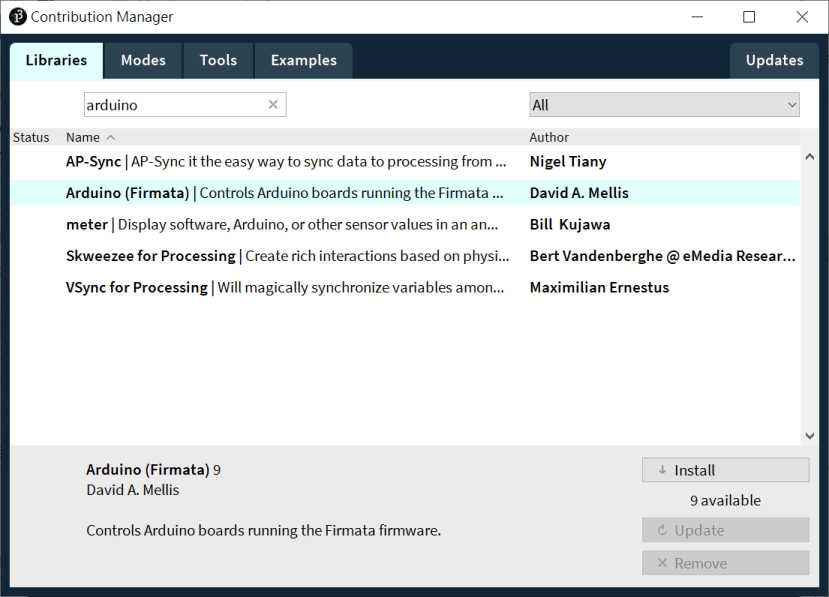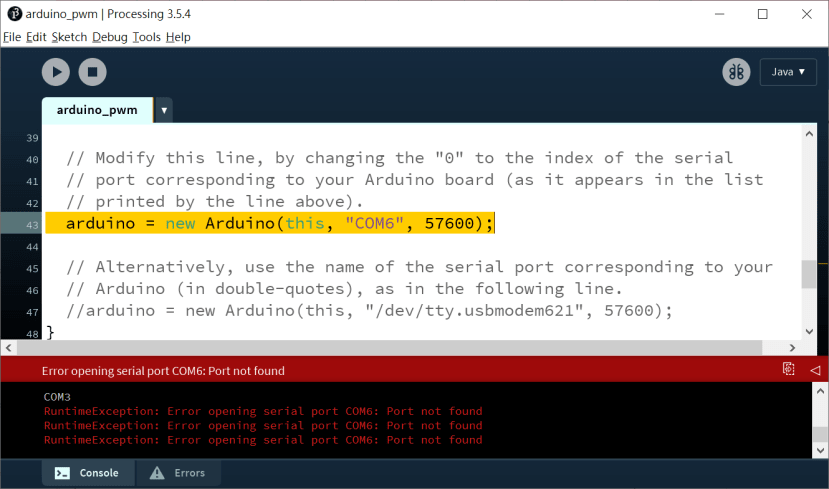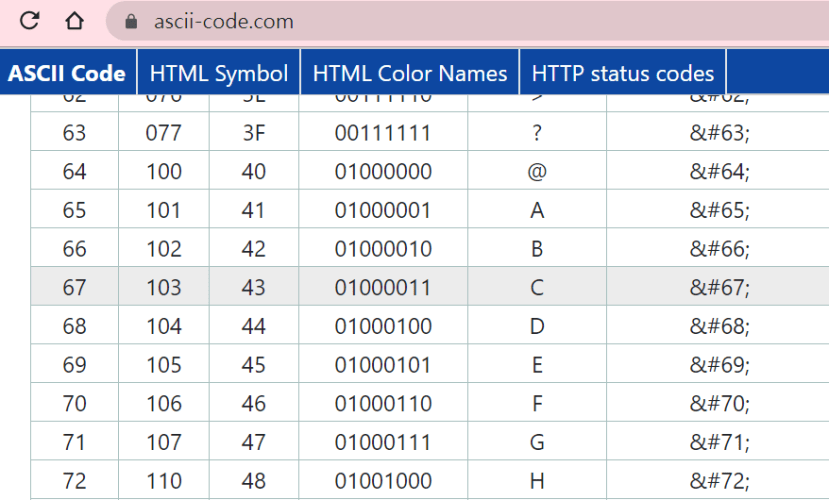Processing數位互動介面開發軟體應用 –結合 Arduino 硬體控制
关注文章你觉得这篇文章怎么样? 帮助我们为您提供更好的内容。
Thank you! Your feedback has been received.
There was a problem submitting your feedback, please try again later.
你觉得这篇文章怎么样?
|
作者 |
曾吉弘 |
|
難度 |
普通 |
|
材料表 |
1. Arduino UNO |
上一篇文章介紹了 Processing 的基礎應用,本篇文章要介紹如何讓 Processing 透過 USB 傳輸線來連結 maker 相當喜愛的 Arduino Uno 開發板,另外也會介紹最近相當有人氣的 LinkIt 7697 開發板。做法有兩種:
- 運用 Arduino 的 StandardFirmata,好處是 Arduino 端不需要再寫程式,只要從 Processing 端發送指令即可,但缺點是彈性較低且較難客製化,例如特殊的感測器就無法直接讀取數值。
- 自行定義USB發送的訊號,好處是可以做到任何您希望的功能。缺點就是程式碼需要對應,Processing 修改了任何地方,Arduino 端都需要做對應的修改。
現在就讓我們看看怎麼做吧。
Arduino 端
在此使用 Arduino Uno 開發板。請下載 Arduino 環境,在此使用 Arduino 1.8.5,更新或再舊一點的版本應該都可以用,StandardFirmata 算是相當早期就有的做法了。燒錄完成之後,請讓 Arduino 接著電腦放著就可以了。
Processing端
請開啟 Processing 官方網站的下載頁面,根據您所使用的硬體平台下載對應的版本,如果還沒下載請參考上一篇。
開啟 Processing IDE,點選 Sketch → Import Library → Add Library,開啟 Contribution Manager 視窗,並搜尋 arduino。點選 Arduino (Firmata) 再點選 Install,就會開始安裝,如下圖:
也會帶入對應的範例,只要是另外安裝的函式庫範例都會為在 Contributed Libraries 下。一共有五個範例,今天會說明其中的:
- arduino_input:把 Arduino 腳位狀態呈現在 Processing 中
- arduino_output:在 Processing 中點選畫面來控制 Arduino 腳位狀態 (數位)
arduino_pwm:在 Processing 中移動滑鼠來控制 Arduino 腳位狀態 (類比)
執行 arduino_input 範例
請直接開啟 arduino_input 範例,這個範例屬於輸位輸入與類比輸入。請確認您的 Arduino 板子正在執行 StandardFirmata 程式,您可以重新插拔電源或按一下 Arduino 板子上的 Reset 按鈕讓它重新啟動程式。總之,當您按下 Processing 的 Run 按鍵時,Arduino 必須先執行程式才行,否則會出現 RuntimeException: Error opening serial port COM6: Port not found 這樣的錯誤訊息。
一切順利的話,會看到下方的畫面,上方的方塊代表 Arduino Uno 的 D0 - D13 數位輸入/輸出腳位,您可以在任一個腳位接上按鈕,按下按鈕就會使對應腳位的方塊變成淺色。而下方的圓圈則代表 Arduino Uno 的 A0 - A6 的類比輸入腳位。
重要指令說明如下:
- import cc.arduino.*; --> 匯入 arduino 函式庫
- Arduino arduino; --> 宣告一個 arduino 物件,如果您的專題需要連接多片 arduino 的話,就需要宣告多個 arduino 物件
- println(Arduino.list()); -->列出可用的 COM port 裝置
- arduino = new Arduino(this, Arduino.list()[0], 57600);--> 設定這個 arduino 物件的 COM port 位置與傳輸速率。list()[0] 代表第一個 arduino,或者您可以改用 “COMX” 來指定位置
- pinMode(i, Arduino.INPUT); → 設定指定腳位為輸入模式
- digitalRead(i) -> 讀取數位腳位狀態,也就是 arduino UNO 的 D0 - D13 腳位
- analogRead(i) → 讀取類比腳位狀態,也就是 arduino UNO 的 A0 - A5 腳位
arduino_input 完整程式碼如下,為避免占版面已刪除註解,請自行開啟 Processing 來看註解:
import processing.serial.*;
import cc.arduino.*;
Arduino arduino;
color off = color(4, 79, 111);
color on = color(84, 145, 158);
void setup() {
size(470, 280);
println(Arduino.list());
arduino = new Arduino(this, Arduino.list()[0], 57600);
for (int i = 0; i <= 13; i++)
arduino.pinMode(i, Arduino.INPUT);
}
void draw() {
background(off);
stroke(on);
for (int i = 0; i <= 13; i++) {
if (arduino.digitalRead(i) == Arduino.HIGH)
fill(on);
else
fill(off);
rect(420 - i * 30, 30, 20, 20);
}
noFill();
for (int i = 0; i <= 5; i++) {
ellipse(280 + i * 30, 240, arduino.analogRead(i) / 16, arduino.analogRead(i) / 16);
}
}
執行 arduino_out 範例
這個範例屬於數位輸出,點選畫面上端的方塊就可以改變該方塊的顏色,並讓 Arduino 對應的腳位為高電位,如果該腳位接一個 LED 的話,就會亮起,再點一次則熄滅。執行畫面如下:
重要指令說明如下:
- pinMode(i, Arduino.OUTPUT);; → 設定指定腳位為輸出模式
- for (int i = 0; i <= 13; i++) { if (values[i] == Arduino.HIGH)... → 根據 value[] 陣列的內容來決定畫面上端方塊的顏色
- digitalWrite(pin, Arduino.HIGH); → 寫入數位腳位狀態,HIGH 為高電位,如果該腳位接一個 LED 的話,就會亮起。反之 LOW 則是低電位(LED熄滅)
arduino_output 完整程式碼如下,為避免占版面已刪除註解,請自行開啟 Processing 來看註解:
import processing.serial.*;
import cc.arduino.*;
Arduino arduino;
color off = color(4, 79, 111);
color on = color(84, 145, 158);
int[] values = { Arduino.LOW, Arduino.LOW, Arduino.LOW, Arduino.LOW,
Arduino.LOW, Arduino.LOW, Arduino.LOW, Arduino.LOW, Arduino.LOW,
Arduino.LOW, Arduino.LOW, Arduino.LOW, Arduino.LOW, Arduino.LOW };
void setup() {
size(470, 200);
println(Arduino.list());
arduino = new Arduino(this, Arduino.list()[0], 57600);
for (int i = 0; i <= 13; i++)
arduino.pinMode(i, Arduino.OUTPUT);
}
void draw() {
background(off);
stroke(on);
for (int i = 0; i <= 13; i++) {
if (values[i] == Arduino.HIGH)
fill(on);
else
fill(off);
rect(420 - i * 30, 30, 20, 20);
}
}
void mousePressed()
{
int pin = (450 - mouseX) / 30;
if (values[pin] == Arduino.LOW) {
arduino.digitalWrite(pin, Arduino.HIGH);
values[pin] = Arduino.HIGH;
} else {
arduino.digitalWrite(pin, Arduino.LOW);
values[pin] = Arduino.LOW;
}
}
執行 arduino_pwm 範例
本範例為類比寫入,把 Processing 視窗上滑鼠的 X 座標轉換為 Arduino PWM 可接受的數值範圍 (0-255)。如果您根據程式說明,在 D9 與 D11 各接一個 LED 的話,當滑鼠慢慢往右移動時,9號LED會慢慢變亮,11號則是慢慢變亮。但當滑鼠往左時,兩個 LED 的亮暗情況就相反了。
其實這個範例與 arduino_servo 可說是完全相同,差別只在於前者是用 arduino.analogWrite() 指令,後者則是用 arduino.servoWrite() 指令來控制伺服機的角度。
執行畫面如下,滑鼠愈靠近視窗左邊,畫面愈黑,反之往右則漸漸變為白色:
重要指令說明如下:
- analogWrite(9, constrain(mouseX / 2, 0, 255)); → 取得滑鼠的 X 座標 (mouseX) 並限制範圍在 0 -255 之間,用來控制 9 號 LED 的亮度
- analogWrite(11, constrain(255 - mouseX / 2, 0, 255)); → 與上一步差不多,但 255 - mouseX 是用來反向控制 LED 亮度。
arduino_pwm 完整程式碼如下,為避免占版面已刪除註解,請自行開啟 Processing 來看註解:
import processing.serial.*;
import cc.arduino.*;
Arduino arduino;
void setup() {
size(512, 200);
println(Arduino.list());
arduino = new Arduino(this, "COM6", 57600);
}
void draw() {
background(constrain(mouseX / 2, 0, 255));
arduino.analogWrite(9, constrain(mouseX / 2, 0, 255));
arduino.analogWrite(11, constrain(255 - mouseX / 2, 0, 255));
}
透過 USB 傳訊號
如果您要接收數位感測器(例如 DHT 11 溫溼度感測器或加速度計),Processing 的 Arduino 函式庫就做不到啦,因為它只支援基本的數位類比 I/O 而已,這時候應該怎麼辦呢?這時候就需要自己定義要收發哪些資料。請看以下說明:
Processing 端
基本的概念就是一個蘿蔔一個坑,Processing 發送什麼,Arduino 端就會根據收到的東西來做事情。這邊的重點就是兩邊一定要對應,否則就會郵差總是按錯鈴啦!影片連結:https://www.youtube.com/watch?v=_EgFOG1MyEk
這裡會用到 Processing 的 Serial 函式庫,請根據先前步驟安裝完成即可。執行畫面如下,按下畫面的方形與圓形區域(請把他們當成按鈕),畫面會變色,且會送出字元 ‘A’ (方形)與 ‘B’ ()給 7697,7697 則根據接受到的指令來做事。請注意 serial 序列傳輸基本的概念就是先發送的資料會先抵達(不考慮掉封包的情況),就好像排隊一樣,同時間只會接收到一筆資料,所以 Arduino 端只要用 if 或 switch 來依序處理即可,相當簡單。
重要的指令說明如下:
- myPort = new Serial(this, Serial.list()[0], 9600); 建立一個新的序列通訊物件,用法與之前的 arduino 物件相當類似
- while (myPort.available() > 0) → 如果 myPort 有接收到資料,代表 Arduino 端有資料傳過來
- int inByte = myPort.read(); 讀取接收到的資料,並存入 inByte 整數變數中。您可能會好奇 Arduino 不是送一個字元 'C' 嗎?為什麼要用整數呢?原因在於序列通訊最基礎的型態是 ASCII 編碼,https://www.ascii-code.com/
- if (inByte == 'C') → 如果收到內容的 ASCII 編碼為 C 也就是 67,對應編碼如下圖:
- write('A'); → 送出字元A,別忘了它的 ASCII 編碼實際上是 65
Processing 端完整程式碼如下:
import processing.serial.*;
int rectX, rectY; // Position of square button
int circleX, circleY; // Position of circle button
int rectSize = 90; // Diameter of rect
int circleSize = 93; // Diameter of circle
color rectColor, circleColor, baseColor;
color rectHighlight, circleHighlight;
color currentColor;
boolean rectOver = false;
boolean circleOver = false;
int bg=0;
Serial myPort;
void setup() {
myPort = new Serial(this, Serial.list()[0], 9600);
size(640, 360);
rectColor = color(0);
rectHighlight = color(51);
circleColor = color(255);
circleHighlight = color(204);
baseColor = color(102);
currentColor = baseColor;
circleX = width/2+circleSize/2+10;
circleY = height/2;
rectX = width/2-rectSize-10;
rectY = height/2-rectSize/2;
ellipseMode(CENTER);
}
void draw() {
update(mouseX, mouseY);
while (myPort.available() > 0) {
int inByte = myPort.read();
if (inByte == 'C') {
bg++;
if (bg>1) bg=0;
if (bg==1) currentColor=color(0,255,0);
if (bg==0) currentColor=color(255,0,0);
}
}
background(currentColor);
if (rectOver) {
fill(rectHighlight);
} else {
fill(rectColor);
}
stroke(255);
rect(rectX, rectY, rectSize, rectSize);
if (circleOver) {
fill(circleHighlight);
} else {
fill(circleColor);
}
stroke(0);
ellipse(circleX, circleY, circleSize, circleSize);
}
void update(int x, int y) {
if ( overCircle(circleX, circleY, circleSize) ) {
circleOver = true;
rectOver = false;
} else if ( overRect(rectX, rectY, rectSize, rectSize) ) {
rectOver = true;
circleOver = false;
} else {
circleOver = rectOver = false;
}
}
void mousePressed() {
if (circleOver) {
currentColor = circleColor;
myPort.write('A'); //送出字元A
}
if (rectOver) {
currentColor = rectColor;
myPort.write('B'); //送出字元B
}
}
boolean overRect(int x, int y, int width, int height) {
if (mouseX >= x && mouseX <= x+width &&
mouseY >= y && mouseY <= y+height) {
return true;
} else {
return false;
}
}
boolean overCircle(int x, int y, int diameter) {
float disX = x - mouseX;
float disY = y - mouseY;
if (sqrt(sq(disX) + sq(disY)) < diameter/2 ) {
return true;
} else {
return false;
}
}
Arduino端
Arduino 端程式較為簡單,重要指令說明如下:
- begin(9600); → 啟動序列通訊,通訊速率為 9600,請注意這時不可開啟 Arduino IDE 的 Serial Monitor,否則 Processing 會因為 COM port 被占用而無法連線
- if (Serial.available()) { → 如果 Serial 有接收到資料,代表 Processing 端有資料傳過來
- char code = Serial.read(); → 將序列埠接收到的資料存在字元變數 code 中
- if (code == 'A') → 判斷 code 值並執行對應的動作(控制兩顆LED)
- print('C'); → 透過序列埠送出字元 C
void setup()
{
Serial.begin(9600);
pinMode(3,INPUT);
pinMode(4,OUTPUT);
pinMode(5,OUTPUT);
digitalWrite(4,LOW);
digitalWrite(5,LOW);
}
void loop()
{
if (Serial.available()) {
char code = Serial.read();
if (code == 'A') {
digitalWrite(4,HIGH);
digitalWrite(5,LOW);
}
if (code == 'B') {
digitalWrite(4,LOW);
digitalWrite(5,HIGH);
}
}
if (digitalRead(3)==LOW) { //如果#3按鈕被按下,送字元 C 給 Processing
Serial.print('C');
delay(200);
}
}
想想看
本篇文章介紹了兩種 Processing 與 Arduino Uno 這類簡易開發板的互動方式,想想看,還有哪些有趣的控制方式呢?














